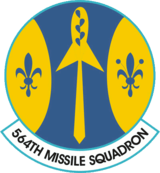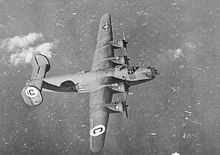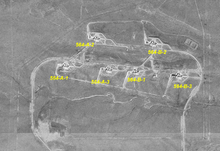564th Missile Squadron
| 564th Missile Squadron | |
|---|---|
|
LGM-30G Minuteman III test launch at Vandenburg AFB, California | |
| Active | 1943-15 August 2008 |
| Country |
|
| Branch |
|
| Type | Squadron |
| Role | Intercontinental ballistic missile |
| Garrison/HQ | Malmstrom Air Force Base, Montana |
| Nickname | Deuce |
| Engagements |
World War II (EAME Theater) |
| Decorations |
Distinguished Unit Citation Air Force Outstanding Unit Award (6x) |
| Insignia | |
| 564th Missile Squadron emblem |
 |

The 564th Missile Squadron (564 MS) is an inactive United States Air Force unit. It was last assigned to the 341st Operations Group, stationed at Malmstrom AFB, Montana.
On 1 December 1958, the 564th Strategic Missile Squadron (ICBM-Atlas) was the first Strategic Air Command (SAC) Intercontinental ballistic missile (ICBM) squadron to go on operational alert status, being equipped with the first-generation SM-65D Atlas, with a mission of nuclear deterrence.
On 1 April 1966, the 564th was re-equipped with the LGM-30F Minuteman II ICBM, and in 1975 was upgraded to the LGM-30G Minuteman III.
The squadron was inactivated due to budget reductions on 19 August 2008.
History
World War II
Activated as a B-24 Liberator heavy bombardment squadron in December 1942; assigned to II Bomber Command for training. Primarily trained in Texas and Colorado. Received deployment orders for the European Theater of Operations (ETO) in April 1943.
Deployed to England in May 1943, being assigned to the VIII Bomber Command and stationed at RAF Hethel. Upon its arrival at Hethel, was sent almost immediately to Libya, where it began operations on July 9, 1943. The detachment flew missions to Crete, Sicily, Italy, Austria, and Romania. Received a Distinguished Unit Citation for the detachment's participation in the famed low-level attack against oil refineries at Ploesti on August 1, 1943. Returned to England in August and the squadron flew several missions against airfields in France and the Netherlands.
The squadron deployed again temporarily to Tunisia during September and October 1943 with the group supporting Allied operations at Salerno and hit targets in Corsica, Italy, and Austria.
Resumed operations from RAF Hethel in October 1943 the squadron engaged in very long range strategic bombardment operations over Occupied Europe and Nazi Germany. Targets included industrial facilities; oil production facilities and refineries, rail and other transportation centers, enemy military airfields and garrisons. The squadron participated in the intensive air campaign against the German aircraft industry during Big Week, February 20–25, 1944.
Continued attacks on enemy targets until the German Capitulation in May 1945; returning to the United States later that month and reforming at Charleston Army Airfield, South Carolina. Unit personnel were demobilized throughout the summer of 1945. Inactivated on 13 September 1945.
Effective 15 September 1947, the squadron was activated at Fairfax Field, Kansas. Having been allotted to the organized reserves, with assignment to Second Air Force, Air Defense Command, it was redesigned as a very heavy bombardment unit on 25 August. In July 1948, the squadron was assigned to the Tenth Air Force, which in December, became a part of the Continental Air Command. The squadron was inactivated on 27 June 1949 due to budget restrictions.
Intercontinental Ballistic Missile Squadron
Atlas-D ICBM era


Reactivated on 1 July 1958 as a Strategic Air Command SM-65D Atlas ICBM launch squadron, stationed at FE Warren AFB, Wyoming and assigned to the 706th Strategic Missile Wing. The 706th SMW was the first United States Air Force ICBM wing to be activated, and the 564th Strategic Missile Squadron became the first missile unit constructed solely for operational purposes.
The 564th was programmed for the above-ground Atlas D ICBM launch and control facilities. Construction delays of the Atlas launch sites led to delays in its operational activation. With General Power (the Commander in Chief of SAC) present, the first Atlas D complex was turned over to the 564th SMS and declared operational on August 9, 1960.
The squadron was assigned six Atlas D missiles. Six launch pads were grouped together, controlled by two launch operations buildings, and clustered around a central guidance control facility. This was called the 3 x 2 configuration: two launch complexes of three missiles each constituted a squadron. The missiles were housed in a "coffin launcher" style complexes. The missile was kept in semi-hard facilities in which the missile was stored above ground horizontally above ground. In order to launch, a 400-ton overhead door was rolled back after which the "bird" was raised to a vertical position. Once upright, the rocket was fueled with RP-1 and Liquid Oxygen after which it would then be made ready for launch. (see below for site details).
Was reassigned to the 389th Strategic Missile Wing on 1 July 1961, replacing the 706th in a name-only re-designation. The Atlas missiles were retired and removed in the summer of 1964 in favor of the more advanced LGM-25C Titan II; squadron was inactivated on 1 September. Missile sites were later sold off to private ownership after demilitarization, although in current aerial imagery both the "A" and "B" sites are very much still intact.
Minuteman ICBM era
On December 14, 1965, the 564th MS was reactivated in its current role as an ICBM squadron at Malmstrom Air Force Base, Mont. Equipped with the then-new Minuteman II missile, it earned its nickname as the "Deuce" squadron and was declared fully operational May 3, 1967.
As a result of the 2005 Quadrennial Defense Review, the 341st Missile Wing deactivated the Minuteman III WS-133B missile system and subsequent inactivation of the 564th Missile Squadron.
"The Minuteman III has served the United States exceptionally during its deployment and will continue to do so," said Col. Sandra Finan, former commander, 341st MW.
Malmstrom AFB currently operates, maintains and secures two types of Minuteman III Rapid Execution and Combat Targeting (REACT) weapons systems; the REACT-A and REACT-B configurations. The wing will deactivate its Minuteman III REACT-B command and control systems, operated by the 564th Missile Squadron. The Minuteman III missiles removed during deactivation will return to the weapon system's flight test and operation programs, extending the system's viable service life.
"The men and women of the 564th Missile Squadron have a distinguished history serving our country and we are proud of the great work they have done to accomplish our strategic deterrence mission," Colonel Finan said.
The 341st Missile Wing will continue to operate, maintain and secure 150 Minuteman III ICBMs and 15 Launch Control Centers providing safe and secure strategic deterrence just like the other two missile wings at FE Warren AFB, Wyo., and Minot AFB, N.D.
The official inactivation ceremony was held on August 19, 2008.
Lineage




- Constituted 564th Bombardment Squadron (Heavy) on 19 December 1942
- Activated on 24 December 1942
- Re-designated 564th Bombardment Squadron, Heavy, on 4 January 1944
- Inactivated on 13 September 1945
- Re-designated 564th Bombardment Squadron, Very Heavy, on 28 January 1947
- Activated in the Reserve on 27 February 1947
- Inactivated on 27 June 1949
- Re-designated 564th Strategic Missile Squadron (ICBM-Atlas) on 1 May 1958
- Activated on 1 July 1958
- Discontinued, and inactivated, on 1 September 1964
- Re-designated 564th Strategic Missile Squadron, and activated, on 14 December 1965
- Organized on 1 April 1966
- Redesignated 564th Missile Squadron on 1 September 1991.
- Inactivated on 19 August 2008
Assignments
- 389th Bombardment Group, 24 December 1942 – 13 September 1945
- Second Air Force, 15 September 1947
- Tenth Air Force, 1 July 1948 – 27 June 1949
- Second Air Force, 15 August 1959
- 706th Strategic Missile Wing, 1 December 1958
- 389th Strategic Missile Wing, 1 July 1961 – 1 September 1964
- Strategic Air Command, 14 December 1965
- 341st Strategic Missile Wing, 1 April 1966
- 341st Operations Group, 1 September 1991 – 19 August 2008
Stations
- Davis-Monthan Field, Arizona, 24 December 1942
- Biggs Field, Texas, 1 February 1943
- Lowry Field, Colorado, 19 Apr-1 June 1943
- RAF Hethel (AAF-114), England, 16 June 1943-c. 28 May 1945
- Operated from Soluch Airfield, Libya, 3 Jul-25 August 1943
- Operated from Massicault Airfield, Tunisia, 19 Sep-3 October 1943
- Charleston Army Airfield, South Carolina, 12 Jun-13 September 1945
- Rapid City Army Air Base, South Dakota, 15 September 1947 – 27 June 1949
- Fairfax Field, Kansas, 15 August 1959
- Francis E. Warren AFB, Wyoming, 1 December 1958 – 1 September 1964
- Malmstrom AFB, Montana, 1 April 1966 – 19 August 2008
Aircraft and missiles
- B-24 Liberator, 1942–1945
- B-29 Superfortress, 1947–1949
- SM-65D Atlas Missile, 1960–1964
- Operated two Atlas missile sites (Site "A", Site "B") of three missiles at each site (6 total) (Sites are adjacent to each other) This was the nation's first ICBM base outside Vandenberg AFB. Because the Atlas D was radio controlled above ground, the launchers had to be clustered close to the radio transmitters. Together the two sites were referred to as "Warren I":
- 564-A, 10.6 mi NW of Federal WY 41°22′44″N 104°58′25″W / 41.37889°N 104.97361°W
- 564-B, 10.6 mi NW of Federal WY 41°22′43″N 104°58′07″W / 41.37861°N 104.96861°W
- LGM-30F Minuteman II, 1967–1975
- LGM-30G Minuteman III, 1975–2008

- Missile Alert Facilities (P-T flights, each controlling 10 missiles) are located as follows:
- P-00 2.9 mi NE of Conrad MT, 48°12′18″N 111°54′31″W / 48.20500°N 111.90861°W
- Q-00 9.0 mi E of Ledger MT, 48°15′37″N 111°37′33″W / 48.26028°N 111.62583°W
- R-00 12.8 mi ExNE of Brady MT, 48°05′42″N 111°34′36″W / 48.09500°N 111.57667°W
- S-00 2.2 mi E of Brady MT, 48°02′14″N 111°47′30″W / 48.03722°N 111.79167°W
- T-00 4.0 mi SxSW of Valier MT, 48°15′09″N 112°16′32″W / 48.25250°N 112.27556°W
- 564th Minuteman Missile Squadron Launch Facilities
Emblem description
Azure, between flaunches Or bearing fleures-de-lis of the first a "sky sword" Yellow charged on the grip with a spring of laurel Blue; all within a diminished bordure Celeste. Approved 15 September 1967 (K 11275), modified on 28 February 1995; replaced emblem approved on 9 July 1959 (10416 A.C.).
See also
Coordinates: 47°30′17″N 111°11′14″W / 47.50472°N 111.18722°W
References
![]() This article incorporates public domain material from websites or documents of the Air Force Historical Research Agency.
This article incorporates public domain material from websites or documents of the Air Force Historical Research Agency.
- Maurer, Maurer, ed. (1982) [1969]. Combat Squadrons of the Air Force, World War II (reprint ed.). Washington, DC: Office of Air Force History. ISBN 0-405-12194-6. LCCN 70605402. OCLC 72556.
- Malmstrom AFB Minuteman Missile Site Coordinates
